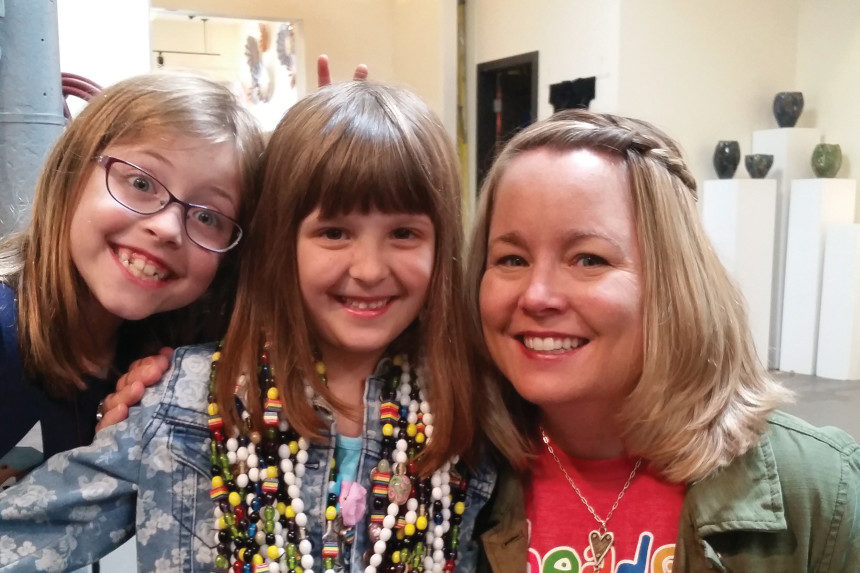The bead photos come to Jean Gribbon from childhood cancer survivors across the country. They’re from women like Chloe, once a sick child, now a Minnesota bride whose bead strands drape across her wedding dress. And Allyson, a beaming high school senior in Georgia whose long hair and colored beads hang over her graduation gown. Seven years earlier, chemotherapy had left Allyson pale and bald. The beads tell the story of their trauma and triumph, and survivors share those stories with Gribbon, the woman who gave them their voice.
In 2021, roughly 10,500 children under the age of 15 will be diagnosed with cancer, and many will find solace in Jean Gribbon’s beads. Gribbon, a pediatric oncology nurse in Tucson, is the founder of Beads of Courage, a nonprofit that uses beads to help children with cancer tell their stories of resilience and pain. Nineteen different glass beads represent unique moments in a patient’s journey. Red is a blood transfusion. White is chemo. Yellow is an overnight hospital stay. The colors, Gribbon says, become a visual language for children in the more than 300 children’s hospitals in eight countries where Beads of Courage works. Children also receive special beads for other nonmedical moments or simply as a morale boost. Since 2003, roughly 60,000 children have participated in the program, and many accumulate 500 to 1,000 beads during their treatments.
“I’ve seen people cry when they see the numbers of beads — they understand that for every bead, a child experienced something painful,” says Gribbon. She compares it to soldiers covered in medals: You may not know what they represent, but you understand the bravery. And hundreds of beads are heavy. Gribbon tells the story of a teenager at a hospital in Greenville, North Carolina, who asked a visitor to hold his beads. “Do you feel that?” he said. “That’s the weight of my courage.”
Gribbon has felt that weight since the age of four. She grew up in rural Minnesota and would play with a boy named Miles on his family’s horse farm. Then Miles was diagnosed with cancer — and Gribbon watched his steady, bedridden decline. Within a year, Miles was dead. Twenty years later, Gribbon was working on her Ph.D. in the nursing program at the University of Arizona when a professor asked a question that would reignite her feelings of loss — and transform her life.
Gribbon tells the story of a teenager who asked a visitor to hold his beads. “Do you feel that?” he said. “That’s the weight of my courage.”
“She asked everyone in class, ‘Why are you pursuing the type of nursing that you are?’” Gribbon recalls. “All those memories of Miles came flooding back. And I knew my life’s purpose was to help children cope with cancer.”
Gribbon was already working as a pediatric oncology nurse but was struggling with a healthcare conundrum: She knew she could meet her patients’ physical needs, but how could she meet their emotional needs?
“Many of these kids are immunocompromised, so they can’t leave their room — you quickly realize they’re held hostage,” says Gribbon. “So for me, it was clear we weren’t doing enough. How can you maintain their emotional well-being when they’re stuck in a hospital room? What could we do to strengthen their quality of life and resilience? Kids with a serious illness really didn’t have a way to communicate with others about their journey.”
In 1999, she volunteered with a medical team at Paul Newman’s SeriousFun Children’s Network Camp in County Kildare, Ireland. Now known as Barretstown, the camp provides seriously ill children with therapeutic activities such as horseback riding and canoeing. Gribbon was struck by the children’s passion for arts and crafts, and when she returned the following year, she noticed that kids were still wearing bead strands they’d created the year before.
“I lose things all the time, so I’m thinking, ‘How did these kids still have the bracelets they made in camp last summer?,’” she says. “That really, really struck me. These beads are important to them.”
Gribbon started researching the history of beads. For over 100,000 years, she learned, humans have used beads as symbols of accomplishment and honor. In 2003, she launched Beads of Courage (beadsofcourage.org) as a pilot program at Phoenix Children’s Hospital, then expanded to Oakland Children’s Hospital in California. But there was a problem: Gribbon was funding it herself and had accumulated $8,000 in credit card debt. “My family said, ‘This is insanity. You cannot do this on your own,’” she says.
She formed a nonprofit in 2005. The beads themselves, handmade by artists nationwide, were her biggest expense. “It was important to me that these aren’t just beads you can get at the local craft store,” she says. She contrasts that with stickers, which nurses often give to young patients. Stickers are disposable. The handcrafted beads are more solid, more distinctive, more permanent.
In Champaign, Illinois, Kate Cox has seen the impact of Beads of Courage on her 10-year-old daughter, Erin, who was diagnosed at the end of 2019 with osteosarcoma, a type of bone and soft-tissue cancer. Erin was treated at Lurie Children’s Hospital in Chicago, where surgeons removed a tumor from her femur. The beads provided motivation.
“They give you a card so that you can write down dates and different procedures, and Erin would write on the back, ‘It’s worth it for a bead,’” says Cox. Erin accumulated about 600 beads, which she would proudly hang on her IV pole. Her knee and part of her femur were replaced with bionic implants, but she finished her chemo in November 2020 and is currently cancer-free.
“When she looks at the big bulk of beads now, it’s that visible feeling of, ‘I did this. I conquered these scary things,’” says Cox. “She knows what the beads all mean. They track the milestones of the journey.”
The beads are also a powerful tool for parents. Moms and dads sometimes wear a strand of their children’s beads when they’re apart, or simply to feel the weight. For Gribbon, helping the many families who want to enroll in Beads of Courage can be a challenge. Roughly 450 children are on a waitlist at hospitals around the country. Others are in hospitals that don’t offer the program. To support those kids, Gribbon and her team launched Beads in the Mail, which has mailed beads to over 3,000 children.
The most excruciating part of Gribbon’s work is when a child dies. “You feel so connected to these families,” she says. But the gratitude of survivors helps sustain her through the losses. In 2018, Danielle, a program participant in Atlanta, visited Gribbon in Arizona to celebrate her 16th birthday and to thank her for Beads of Courage. The two had first met eight years earlier when Danielle was battling cancer. The transformation was startling.
“Here she is, this healthy, vibrant 16-year-old and the last time I saw her she had no hair and was in the active treatment phase for cancer,” says Gribbon. “And we went on a hike together. It was an amazing moment for me.”
Ken Budd is the author of The Voluntourist. His work appears in the 2020 edition of The Best American Travel Writing.
This article is featured in the May/June 2021 issue of The Saturday Evening Post. Subscribe to the magazine for more art, inspiring stories, fiction, humor, and features from our archives.
Featured image: Bead-dazzled: Pediatric oncology nurse Jean Gribbon (right) compares young bead-wearing cancer survivors to soldiers covered in medals. “For every bead, a child experienced something painful.,” she says. (Courtesy Beads of Courage)
Become a Saturday Evening Post member and enjoy unlimited access. Subscribe now



